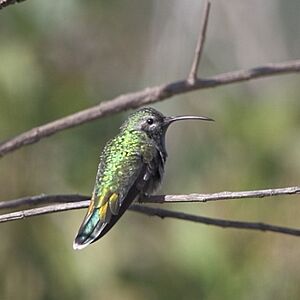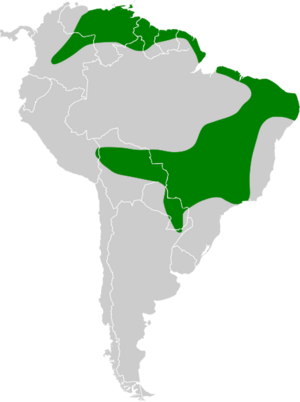White-tailed goldenthroat facts for kids
Quick facts for kids White-tailed goldenthroat |
|
|---|---|
 |
|
| White-tailed goldenthroat at Dourado, São Paulo state, Brazil | |
| Conservation status | |
| Scientific classification | |
| Genus: |
Polytmus
|
| Species: |
guainumbi
|
 |
|
| Synonyms | |
|
Polytmus thaumantias |
|
The white-tailed goldenthroat (Polytmus guainumbi) is a beautiful type of hummingbird. These tiny, fast birds are known for their bright colors and quick movements. They belong to a group of hummingbirds called "mangoes."
You can find the white-tailed goldenthroat in many countries across South America. These include Argentina, Bolivia, Brazil, Colombia, French Guiana, Guyana, Paraguay, Peru, Suriname, Trinidad and Tobago, and Venezuela.
Contents
About the White-tailed Goldenthroat
The white-tailed goldenthroat was once known by a different name, Polytmus thaumantias. Today, scientists recognize three slightly different types, or subspecies, of this bird. These are P. g. guainumbi, P. g. andinus, and P. g. thaumantias. Each subspecies has small differences, often in their looks or where they live.
What Does It Look Like?
The white-tailed goldenthroat is a small bird, usually about 9.7 to 11.8 cm (3.8 to 4.6 in) long. That's about the length of your hand! It weighs only 4.4 to 5 g (0.16 to 0.18 oz), which is less than a coin.
All white-tailed goldenthroats have a long, curved beak that is reddish and black. The male birds have shiny, golden to bronzy-green feathers on their backs. Their tails are long and rounded. Most tail feathers are green, but the tips are white. The outer three pairs of feathers also have wide white edges.
Around their eyes, the feathers are dark gray with white stripes above and below. Their chests and bellies are a shimmery golden-green. Female birds look a bit different. They have pale streaks on their faces and a whitish chin. Their undersides are a light tan color with green spots on their throat and chest.
The different subspecies have small variations. For example, P. g. andinus has more white on its inner tail feathers. P. g. thaumantias has a slightly shorter beak and more reddish-gold feathers on its back. It also has less white on its outer tail feathers.
Where Do They Live?
White-tailed goldenthroats live in many different places. The main subspecies, P. g. guainumbi, lives in Trinidad and from Venezuela through the Guianas into northern Brazil.
Another subspecies, P. g. andinus, is found in eastern Colombia. The P. g. thaumantias subspecies lives from southeastern Peru across Bolivia and Brazil. It also extends south into eastern Paraguay and northeastern Argentina. In eastern Brazil, it can be found from Maranhão south to northern Paraná.
These hummingbirds like various types of land. They live in wet grasslands, bushy savannas, and freshwater swamps. In drier areas, they usually stay close to water. You can find them from sea level up to about 600 m (2,000 ft) high.
How They Live
Movement and Migration
Most white-tailed goldenthroats stay in the same area all year. They are mostly "sedentary," meaning they don't move much. However, some birds on Trinidad move around a bit after their nesting season. It also seems they only visit Brazil's Mato Grosso do Sul state and northeastern Argentina during the winter months.
What Do They Eat?
The white-tailed goldenthroat mainly eats nectar from flowers. They visit garden plants, shrubs, and trees to find their food. They usually feed alone and stay close to the ground. Besides nectar, they also catch insects while flying. They also pick up insects and spiders from plants.
Reproduction and Life Cycle
The breeding season for white-tailed goldenthroats changes depending on where they live. The female bird does all the work of building the nest, sitting on the eggs, and raising the young.
She builds a small, cup-shaped nest using soft plant fibers. She often decorates it with lichen. The nest is usually placed in the fork of a shrub, about 0.5 and 1 m (1.6 and 3.3 ft) above the ground. A female typically lays two eggs. The eggs hatch after 14 to 15 days. The young birds are ready to fly, or "fledge," about 20 to 22 days after they hatch.
Their Sounds
White-tailed goldenthroats are quite chatty, especially when they are looking for food. They make a "fast-paced series of loud, excited 'spit' notes." When they fly, they also make a dry "tsip-tsip" sound.
Conservation Status
The IUCN (International Union for Conservation of Nature) has listed the white-tailed goldenthroat as a species of "Least Concern." This means they are not currently in danger of disappearing. However, scientists don't know exactly how many of these birds there are or if their numbers are growing or shrinking.
They are common in most places they live. But they are less common in Trinidad and rare in French Guiana. The good news is that their homes, or "habitats," are not seriously threatened in many areas.


